Hammock Camping Part III: Helpful tips and resources for a virgin hammock camper
“In locations where trees are readily available—nearly all of the eastern United States plus a fair amount of the Mountain West—a hammock is likely the best sleep system.”
This is part of a three part series
- Part I: Advantages and disadvantages versus ground systems
- Part II: Types of hammocks, and spec comparisons to ground systems
- Part III: Helpful tips and resources for a virgin hammock camper
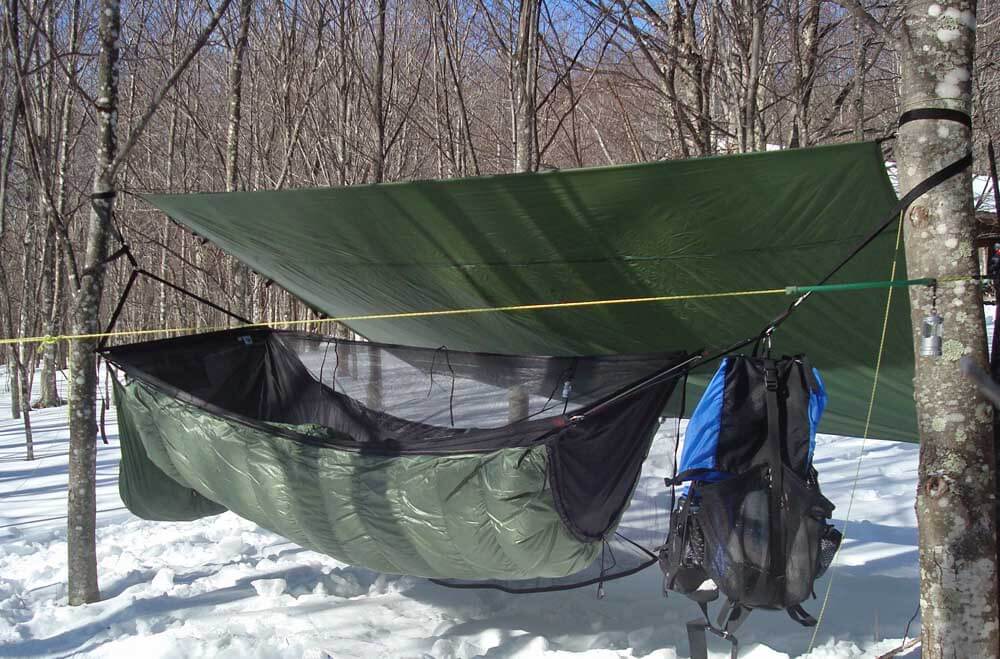
Hammock camping in cold weather is an advanced skill, perhaps even more so than ground camping in the same weather. For beginner hammock campers, test your system on low-risk, short-term outings first in order to develop your skills and know-how. Note the full-length under quilt for winter temps. Photo by Jack Tier of Jacks ‘R’ Better.
Shopping tips: How to assemble a functional hammock system
The hammock
Buy your hammock from a manufacturer that specializes in backpacking hammocks. Make sure it is designed for nightlong sleeping, not just afternoon napping.
A few light hammock models use smaller dimensions that may confine you. For example, the Grand Trunk Nano-7 Hammock, and the BIAS Weight Weenie Micro 52 Hammock are both only around 50-52 inches wide, versus the 65″ wide of the Warbonnet Blackbird. Shorter and/or narrower hammocks also limit your ability to sleep flatter on a diagonal to the hammock’s center-line.
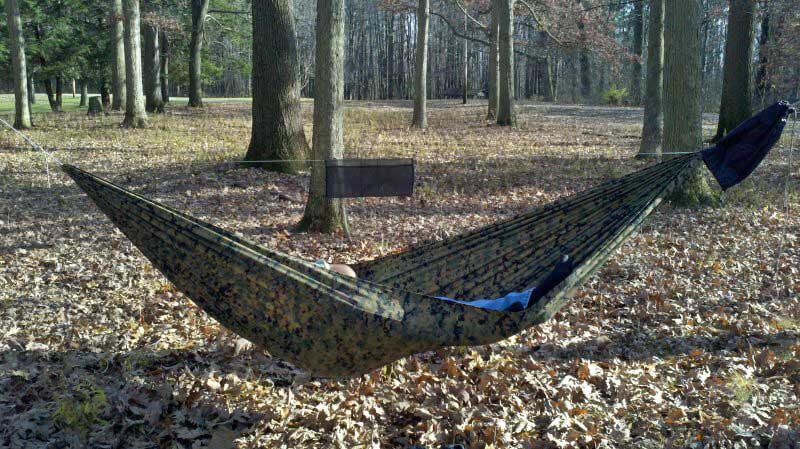
Even a light hammock should be full sized and functional. The 12 oz, $75 Dream Hammock FreeBird is a full 11 feet long and 60 inches wide.
Some campers pushing into the 175+ lb weight range are fine with lighter hammock body fabrics (e.g. 1.0-1.1 oz nylon). Other campers in the 175+ lb weight range feel that these lighter hammocks do not give enough body support even if they are technically within the hammock’s weight range, and therefore opt for 1.7-1.9 oz or heavier hammock body fabrics.
The tarp
Buy a tarp with adequate coverage. To sleep warm and dry in a hammock you need to keep wind and rain away from your hammock body. Smaller diamond or asymmetric tarps, e.g. the Hennessey Hyperlite Rainfly, affectionately known by some as a “napkin tarp,” may not provide adequate protection from blowing rain, or from the cooling effects of wind. While a few ounces heavier, a more pragmatic choice may be a larger hammock-specific “hex” tarp. A fairly standard hex size is a 10.5-foot ridgeline with an 8.5-foot width.
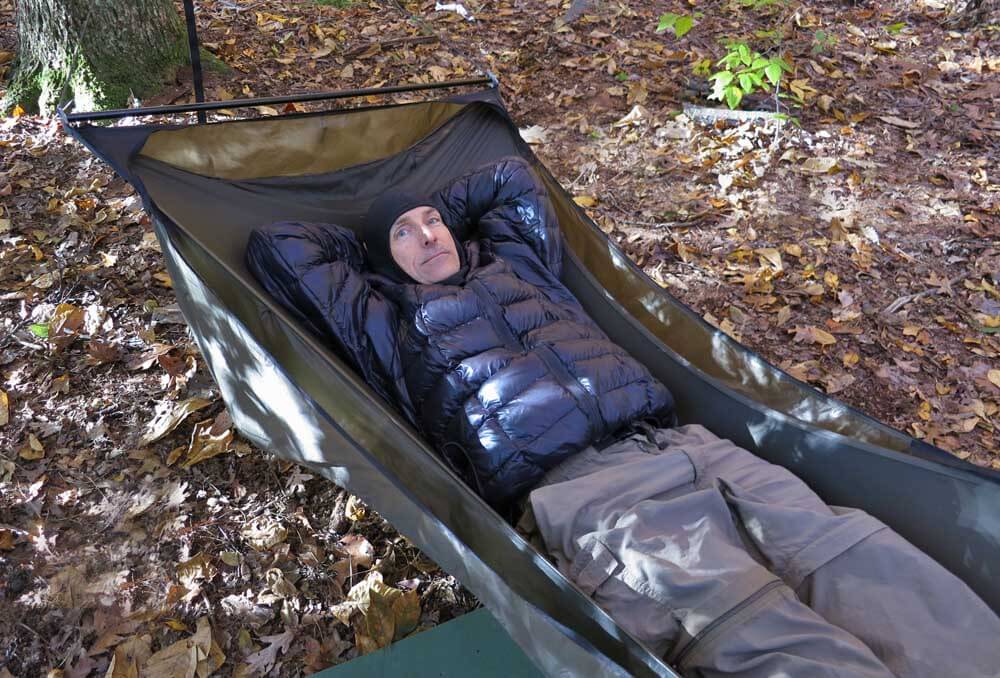
Due to spreader bar width, bridge hammocks may require a wider tarp than gathered end hammocks. (Pictured Warbonnet Ridge Runner hammock)
Due to the large tarps typically used with hammocks, some campers have opted to go with Spinnaker or Cuben fabric tarps to save weight. Compared to sil-nylon, Cuben fiber weighs half as much, but costs 2-3x as much (about $250-300 for a hammock tarp).
The under-quilt
Buy a good under-quilt for your hammock. Its performance will be much superior to a ground pad, even if you have a double-layer hammock to properly control the pad.
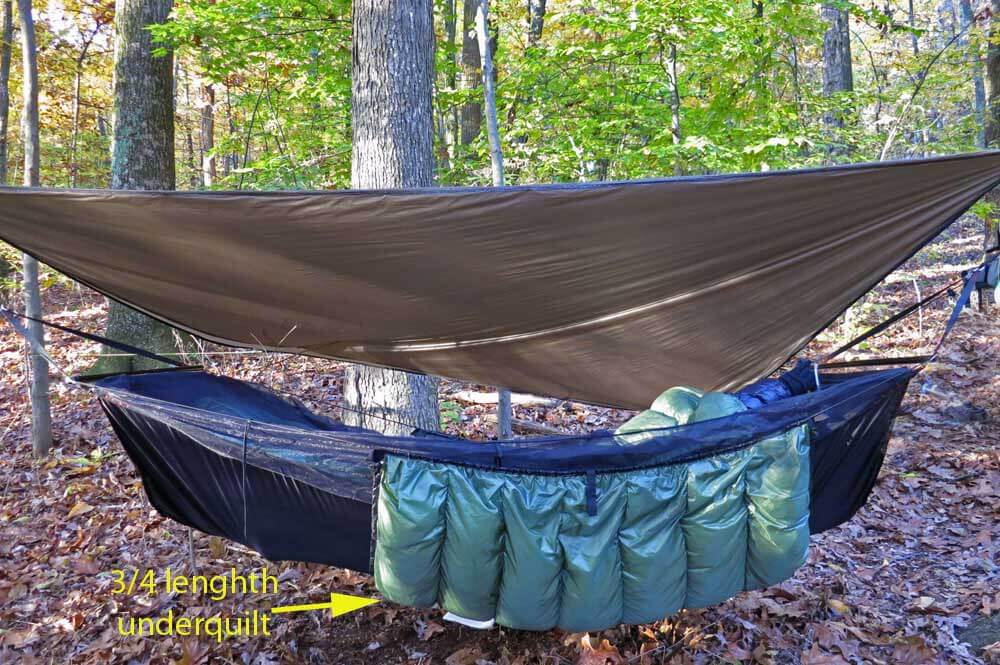
A good under quilt will make a critical difference for warmth and comfort. Some use a 3/4 length quilt and use a small pad under their feet, typically a foam sit-pad (which I prefer). Others opt for a full length under quilt.
The top quilt
Buy a top quilt when you can afford one — they are much more hammock-friendly than conventional mummy bags. In the interim you can use an unzipped mummy spread out like a quilt.
Suspension systems
Avoid fussing about exotic suspension systems and hanging hardware. The basic webbing suspension systems supplied by manufacturers like JRB and Warbonnet are excellent — inexpensive, easy to use, and strong. At most, they weigh a few more ounces than more expensive exotic suspension systems.
Drip lines
If you own a gathered end asymmetric hammock, make sure you have drip lines, or place a carabiner on the suspension system near the attachment to the hammock body. Otherwise, water will run down the suspension and into your hammock. Bridge hammocks do not share this problem.
Some Great Hammock Choices
In addition, I’ve listed key hammock manufactures and purchasing resources below. I own and like hammocks from all these companies. I know all their owners personally. They produce excellent hammocks that have widespread use and good reputations. Most also offer all the hammock accessories you might need, top quilts, under-quilts, tarps etc. Give them a call if you have questions on how to equip or comment below and I’ll try and answer.
| Company | Hammock | Oz | Comments |
|---|---|---|---|
| Dutchware | Chameleon | 17.5* | Light & Superbly Versatile. Adaptable to every season from humid summer days to winter use. Full review here which also compares it to Hennessy and Warbonnet hammocks. [5 day turnaround time.] |
| Hennessy | Hyperlight Asym Zip | 22 | Tom Hennessy is considered the man responsible for modern backpacking hammocks as we know them & has the patents to prove it. This is their lightest hammock & available at REI. |
| Warbonnet | Blackbird | 22 | A longtime hammock manufacturer. Blackbird is their most popular hammock. A well thought out and functional design. [Only 1 week wait] |
| Jacks ‘R’ Better | Bear Mountain Bridge Hammock | 32† | Another veteran hammock Co. The Jacks ‘R’ Better hammocks use a bridge design that gives a flatter lie than the gathered-end (traditional) hammocks above. [Almost all JRB stuff is off-the-shelf and ready to ship.] |
| Dutchware | 11 ft Netless | 8.0* | Ultralight and only $42! It’s my favorite hammock for littel to no bug pressure (much of Spring and Fall). Simple and functional. [Only 1 day turnaround time.] |
| AntiGravity-Gear | Quicksilver UL | 10.4 | Another inexpensive, light, no nonsense, netless hammock that comes with a very light suspension system. |
| Hammock Gear | All hammock accessories | n/a | Great supplier of everything else you need for hammocks. Top quilts, under-quilts, tarps etc. Some very light gear and some great values including their $150 Econ +20F down quilt. |
* Weights are approximate, and unless noted include MFR’s suspension (cord to hang hammock and wide tree straps to protect trees—important for LNT!). Dutchware Chameleon and Netless hammocks weights are with my own Kevlar tree straps.
† approx. 24 oz if you can use your trekking poles as the spreader bars.
Hammock-specific How To resources
The Ultimate Hang: An Illustrated Guide to Hammock Camping, by Derek Hansen, is an excellent and comprehensive book for hammock camping. And the Kindle version is only $3.99.
Hammock Forums is the largest online resource for information on hammocks. Like any large internet forum, its well intended members offer an incredible wealth of information. Also, as with any large internet forum, there is a smidge of less-than-perfect information, plus a couple of folks who are hanging in a different planetary orbit.
Warbonnet Outdoors has two useful how-to sections on its website: Hammocks 101 and setup videos.
Hennessy Hammock also has very good how-to videos.
Dutchware Product’s amusing videos are fun even if you don’t buy his stuff, though he does design some good products too.
Hammock Camping — The Basics
Derek Hansen, author of The Ultimate Hang, is an advanced hammock camper and excellent illustrator. If you have learned nothing else from this 3-part series, study Derek’s illustration below.
What critical tips for first-timers are missing?
If you are a veteran hammock camper and feel that I missed some important tips — in this post, or one of the first two — for first-time hammock campers, please submit it as a comment, below.

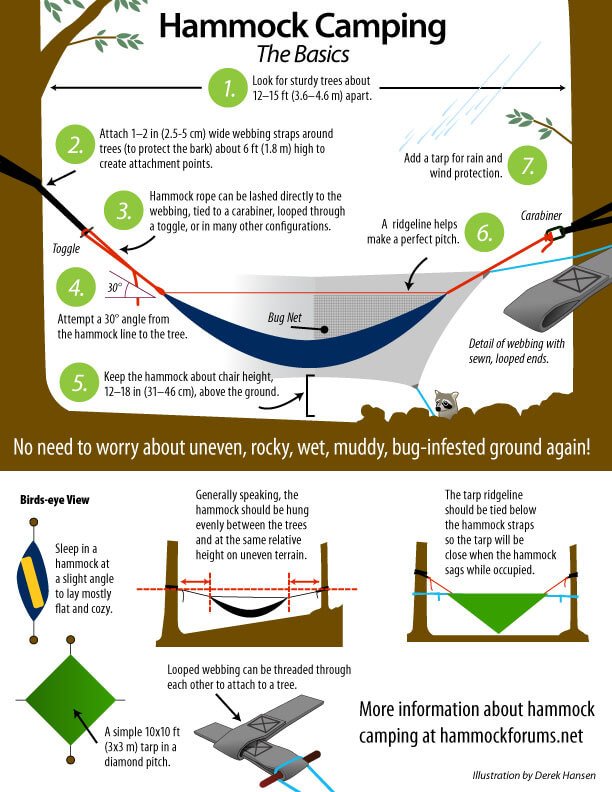

Thank you! I’ve just ordered a 20 deg F top quilt from Massdrop, and have a Jarbridge underquilt I’ve used a couple of times, so I wasn’t eager to haul another sleeping pad along. Since the CDT is about $50 cheaper than the Exodus and they have similar volumes and weights, is there a compelling reason to go with the more expensive option?
BTW, thank you for taking the time and trouble to share your knowledge and experience online. I just combined a 3-day section hike on the AT in MD with a business trip in DC, using your low-carbon trip report both as a guide to the walk and as inspiration to take the train into DC. Saved a bundle on downtown parking, and got a great hike to boot!
Tim, they are both fine packs. You wouldn’t go wrong with either. Awesome to hear that you did and enjoyed the low-carbon thing! I know other readers would love to see a short comment by you there as well. Best, -a
Oops–I did comment, but didn’t pay attention to the word “short.” I guess that’s what the scroll button is for….
No worries. Nice post. All is good!
What pack(s) do you generally use to carry your hammock rigs? Buying a frameless pack (such as the ULA CDT or MLD Exodus) to replace my Deuter ACT Lite 65+10 (70 oz!) has me worried that the load will be uncomfortable without a sleeping pad to stiffen up the pack. Do you use a pack with light internal stays, one with a removable sit pad, or just arrange the load in some way that the pack doesn’t slump or poke you in the back?
Hi Tim. Since you are likely carrying both a top and bottom quilt, and not compressing down too much is best… you are likely to need pack volume. Exodus volume is a good choice. After that it’s a personal comfort thing. For me under about 20 lb framless is fine. And I just pack it right so that holds its shape (semi-frame) and nothing is poking in my back. In general a sit pad in the pack takes up a bunch of volume.
Other find that for anything over about 12 pounds they prefer a frame. Then you are looking at something like an ULA Ohm, HMG SW 2400, or Z-packs in that volume range. Obviously for a bit more weight there are a lot of less expensive framed packs in that volume range too like Osprey. Have a great hike, -alan
The Pictures Seem to Be Missing!
Working on it Part 1 is up and fixed!